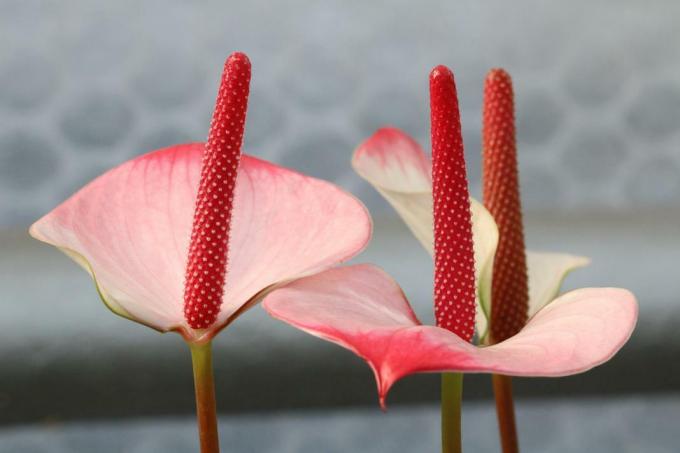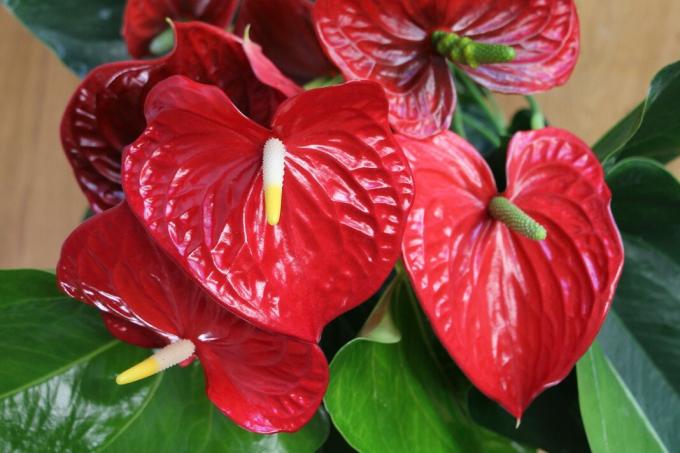
table of contents
- Toxicity
- Poisonous plant parts
- Symptoms of poisoning
- First aid in case of poisoning
- With children
- With pets
The special charm of the anthurium, better known as the flamingo flower, is made up of its white or red, heart-shaped bracts and the strikingly long cobs. You can see it on many window sills, where it makes for a nice splash of color. There is one small downer, however, and that is the toxicity of the anthurium. This should be taken into account especially when small children or Pets live in the household to avoid damage to health.
Toxicity
How poisonous is the anthurium?
The name flamingo flower is derived from the Greek words 'anthos' for flower and 'oura' for tail and refers to the bulb-shaped inflorescence. The anthurium (Anthurium) from the family of the arum plants is slightly poisonous. This property is supposed to protect the plant from supposed enemies in the wild.
Since the flamingo flower is kept as an indoor plant in many households, its poison can be dangerous for children and pets. However, cultivated species are said to be less poisonous than wild forms. With normal handling, the flamingo flower does not pose any great danger. It looks different when small children live in the household. Eating poisonous parts of plants can have dire consequences for them.
Pets such as dogs, cats, parakeets and rodents also often have the habit of nibbling on one or the other houseplant. It is often assumed that animals instinctively avoid plants that are poisonous for them, but this is rarely the case. Young cats and puppies are particularly at risk.

tip: To protect against poisoning, children up to a certain age should be poisonous Houseplants better do without. At the very least, they should be placed in such a way that neither children nor pets can reach them.
Poisonous plant parts
- The entire plant contains poison
- Highest concentration in the leaves
- Anthurium belongs to the arum family
- Is not as poisonous as z. B. the arum
- Toxicity is due to calcium oxalate crystals and oxalic acid
- Other poisons are alkaloids and saponins
Calcium oxalate is an element found in many stones, even kidney stones. On the other hand, soluble salts of oxalic acid can also be found in many plants, e.g. B. in sorrel and rhubarb. Symptoms of poisoning can appear externally, in the form of skin irritations and rashes, as well as internally.
Symptoms of poisoning
The symptoms are very similar in children and animals. The poison of the anthurium can cause irritation and damage to the mucous membranes. Shortly after consuming poisonous plant parts, nausea, vomiting, diarrhea and increased salivation can occur. The tongue can swell severely and cause pain when swallowing. Externally, redness and blistering can appear.
Most of the symptoms usually go away after 2-3 hours, depending on how much poison was absorbed or how much. in what concentration. Nevertheless, a visit is at doctor especially recommended if children are affected. In unfavorable cases, bleeding in the gastrointestinal tract is even possible. These or similar symptoms can also be observed in pets.
First aid in case of poisoning
With children
- First measure if poisoning is suspected, supply of plenty of fluids
- Affected people should drink as much as possible, preferably water
- Under no circumstances do fatty drinks such as B. Give milk
- Excessive hydration is supposed to flush the toxin out of the body
- Symptoms should be alleviated and slowly subside
- A visit to a doctor is recommended even after the symptoms have subsided
- The younger the child, the more important it is to see a doctor
In particularly bad cases, which are usually not to be expected with the flamingo flower, a call can be made to the Poison Control Center be advisable. Among other things, information is required there about which plant it is, which parts of the Plant were eaten and whether the whole thing was only chewed and spat out or also swallowed and how much.
With pets
It is generally a little more difficult to induce pets to consume more water. Cats in particular have their own mind. They do not ingest fluids as readily as children, for example. In order to ensure that they absorb as much liquid as possible, one can try to mix a larger amount of water with the food. However, if symptoms of poisoning do appear, it makes sense to consult a veterinarian here too. Since cats in particular like to eat all kinds of plants, they should be given access to Cat grass or Catnip so that they avoid poisonous houseplants in the best case.

Note: Please note that this article does not in any way replace a visit to the doctor. There is no guarantee that medical statements are correct. You will find detailed information on first aid in the event of poisoning and important information on poison control centers here.




